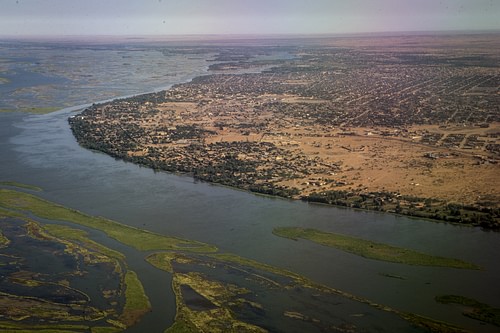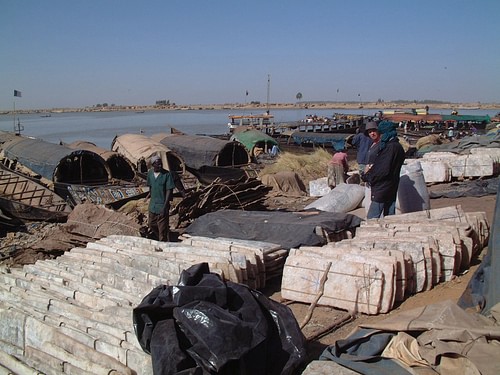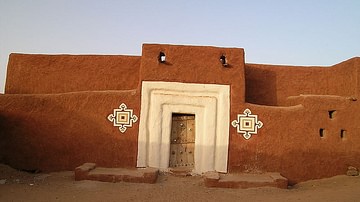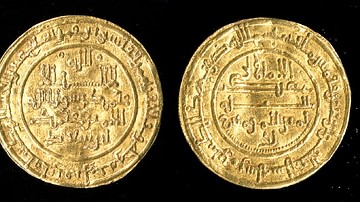
The Songhai Empire (aka Songhay, c. 1460 - c. 1591) covered what is today southern Mauritania and Mali. It replaced the Mali Empire (1240-1645) as the most important state in West Africa. Originating as a smaller kingdom along the eastern bend of the Niger River c. 1000, the Songhai expanded their territory dramatically from the reign of King Sunni Ali (1464-1492).
With its capital at Gao and managing to control trans-Saharan trade through such centres as Timbuktu and Djenne, the Songhai empire prospered throughout the 16th century until, ripped apart by civil wars, it was attacked and absorbed into the Moroccan Empire c. 1591.
Decline of the Mali Empire
The Mali Empire, located along the savannah belt between the Sahara desert to the north and the forests of southern West Africa (often referred to as the Sudan region), had prospered through its control of local and international trade, especially in gold and salt, since the mid-13th century. However, the empire began to collapse in the 1460s following civil wars, the opening up of competing trade routes elsewhere, and attacks from the nomadic Tuareg of the southern Sahara and then the Mossi people, who at that time controlled the lands south of the Niger River. Worse was to come, though, with the rise of the Songhai Empire, an ancient kingdom but now more powerful than ever. The Mali Empire would cling on to the western corner of its once vast territories, that is until the Moroccans arrived in the 17th century.
King Sunni Ali
The kingdom of Songhai dates back to at least the 9th century and was contemporary with the Ghana Empire (6-13th century) further to the east. It was dominated by and named after the Songhay (aka Sonhrai), a group of Nilo-Saharan-speaking peoples. Although conquered by the Mali Empire, the Songhai people would prove troublesome and powerful because they controlled river transport on the Niger. The Songhai kings made regular raids on Mali urban centres from the early 15th century and ultimately won their independence as the Mali kings lost their grip on several smaller subjugated kingdoms on the periphery of their empire.
Around 1468, King Sunni Ali (aka Sonni Ali Ber) changed the traditional Songhai tactic of small and sporadic raids on its enemies to a more sustained campaign of permanent territorial expansion. With an army equipped with armoured cavalry and the only naval fleet in North Africa, which he deployed on the Niger River, Sunni Ali was able to conquer the rump of the old Mali Empire. As the Timbuktu chronicle, the Tarikh al-Sudan (c. 1656) notes:
[He reigned] for 28 years, waged 32 wars of which he won every one, always the conqueror, never the conquered.
(quoted in de Villiers, 102)
The Songhai king played on his image as a magician of the indigenous animist religion to strike fear into his enemies. He also effectively mixed leniency (conquered warriors were invited to join his own army, for example) with complete ruthlessness (infamously executing many of the particularly resistant Fulbe tribe). Hence, the king earned his epithet, 'Sunni the Merciless'. Even more effective than these strategies was Sunni Ali's battle tactics of attacking the enemy with overwhelming force and with the utmost speed. Conquered territories fell like dominoes and were divided up into provinces and ruled by a governor appointed by the king. Tribute was extracted from local chiefs, hostages taken and marriages of political alliance arranged, but at least Sunni Ali did build many dykes which improved the irrigation and agricultural yield of many areas.
The Songhai & Trade
By 1469 the Songhai had control of the important trade 'port' of Timbuktu on the Niger River. In 1471 the Mossi territories south of the Niger River bend were attacked, and by 1473 the other major trade centre of the region, Djenne, also on the Niger, had been conquered. Unfortunately for Sunni Ali though, all this new territory did not give him access to the goldfields of the southern coast of West Africa that both the Ghana and Mali rulers had grown rich on. This was because a Portuguese fleet, sponsored by the Lisbon merchant Fenão Gomes, had, in 1471, sailed around the Atlantic coast of Africa and established a trading presence near these goldfields (in modern Ghana).
The opening up of the sea route to the Mediterranean would also mean the trans-Saharan camel caravans now faced serious competition as the best way to get trade goods to North Africa and Europe. However, the Portuguese were not quite so successful as they had hoped in exploiting Africa's resources. Certainly, the Songhai in any case managed to monopolise the Saharan caravan trade which brought rock salt and luxury goods like fine cloth, glassware, sugar, and horses to the Sudan region in exchange for gold, ivory, spices, kola nuts, hides, and slaves. Timbuktu, with a population of around 100,000 in the mid-15th century, continued to thrive as a trade 'port' and as a centre of learning into the 16th and 17th centuries when the city boasted many mosques and 150-180 Koranic schools.
Trade centres, in particular, became sophisticated urban centres with housing built in stone and many having a large public square for regular markets and at least one mosque. Around this core was a floating suburban population living in mud and reed houses or tents. Rural communities, meanwhile, continued to be wholly dependent on agriculture, but the presence of rural markets indicates there was usually a food surplus. Certainly, famine was a rare event during the first half of the Songhai Empire's reign, and there are no records of any peasant revolts.
Songhai Government
The Songhai government was much more centralised in respect of the more federal arrangements of the earlier Ghana and Mali Empires. The ruler was an absolute monarch but despite having around 700 eunuchs at his court in Gao, the Songhai kings were never quite secure on their thrones. Of the nine rulers in the Songhai Empire's history, six were either deposed in rebellions or died violent deaths, usually at the hands of their brothers and uncles.

Should a king reign long enough to benefit from it, there was an imperial council of the most senior officials which included the finance minister (kalisa farma), the admiral (hi koy) of the Songhai fleet who also supervised the regional governors, the head of the army (balama), and the minister of agriculture (fari mondzo). There were also ministers responsible for forests, wages, purchases, property, and foreigners. A chancellor-secretary dealt with the official paperwork. At the local level, there were many officials with specific duties such as policing or checking the use of official weights at trading centres, as well as heads of local craft guilds and tribal groups. One official who nobody could escape from, although the rich had to pay him more than the less well off, was the local tax collector, who gathered in goods for the crown to pay the army, court, and provide some provision for the poor.
King Mohammad I
King Mohammad I (r. 1494-1528), a former Songhai army commander who had wrested the throne from Sunni Ali's son, Sonni Baro, began the use of the dynastic title Askiya or Askia (meaning 'ruler' or perhaps even 'usurper ruler'). The new king, forming a fully professional army for the first time, would oversee the greatest territorial extent of the Songhai Empire, earning his place as the Songhai's second greatest leader after Sunni Ali.
The loss of control of a slice of West Africa's gold trade to the Portuguese may have been one of the reasons for King Mohammad's decision to expand the Songhai Empire interests to the southeast. Three major cities of Hausaland, located between the Niger River and Lake Chad, were, according to the historian Leo Africanus (d. c. 1554), attacked: Gobir, Katsina and Zaria. The fourth major city in the region, Kano, was obliged to pay a hefty tribute to the Songhai king.
The capital at Gao in this period boasted an impressive 100,000 inhabitants and the empire stretched almost from the Senegal River in the west to what is today central Mali in the east. In addition, the territory included the lucrative salt mines at Tagahaza in the north. The Songhai Empire completely dominated almost the whole stretch of the Niger River, West Africa's trade superhighway so that the Songhai peoples were now a small minority group in a state that encompassed such diverse groups as the Mande, Fulbe, Mossi, and Tuareg.
Islam & Animism
The Islamic religion, long-established in other empires in the Sudan region like Ghana and Mali, had a somewhat precarious existence in the Songhai Empire, at least initially. King Sunni Ali observed certain Islamic practices like the Ramadan fast for political expediency only (he also sacrificed animals to trees and supported pagan sorcerers) and was vehemently anti-Muslim in that he persecuted without mercy Muslims who were a political threat (Fage, 424). In contrast, King Mohammad I (as his name would suggest) was a convert and he even made the pilgrimage or hajj to Mecca where he received the honorary title of the Caliph of the Sudan. Mohammad imposed Islamic law on his people, appointed qadis (Islamic magistrates or judges) as heads of justice at Timbuktu, Djenne and other towns, and engaged the services of the North African Mohammad al-Maghili as his government advisor. The works of the latter would become an important part of the Islamic reform movement that swept the region from the 18th century. Certainly, an urban elite developed which was predominantly Islamic. Not just made up of wealthy merchants, there also sprang up a class of religious scholars whose texts not only examined the ins and outs of their religion but also produced works on many other subjects from science to history.
King Mohammad may even have tried to impose Islam as the state religion but, as in the Songhai's predecessor states in the Sudan region, Islam was largely limited to the elite and urban populations while rural communities and the greater part of the population remained loyal to their traditional animist beliefs. In the latter religion, it was thought that spirits possessed certain objects, especially impressive natural phenomena, trees, caves, and prominent natural features. The two most important spirits were Harake Diko and Dongo, linked to the Niger River and thunderstorms respectively, which is hardly surprising given the importance of the river to trade and rain to the dry savannah of West Africa. These spirits and others (notably those belonging to dead ancestors) had to be constantly kept in a good mood, hence they were made offerings of food and drink and honoured with masked dances and ceremonies. More a belief system than a formal religion, there were, nevertheless, practising priests, the tierkei or sorcerers, who made it their business to minimise the interference of evil spirits in village affairs.
Why Did the Songhai Empire Decline?
The Songhai Empire began to shrink around the edges, especially in the west, from the last quarter of the 16th century. This was largely due to a string of ineffectual leaders and civil wars for the right of succession which had blighted the empire ever since the death of King Mohammad in 1528. One particular rivalry, between Mohammad IV Bano (r. from 1586) and his brothers, effectively divided the empire in half. Then the final deathblow was swift. The Moroccan leader Ahmad al-Mansur al-Dhahabi (d. 1603), known rather grandly as 'the Golden Conqueror', sent a small force of perhaps 4,000 men armed with muskets to attack the empire in the 1590-1. The Songhai army numbered some 30,000 infantry and 10,000 cavalry, but their weapons were mere spears and arrows. As a result of this technological mismatch, the Moroccans won the war, even if there were a few sporadic but ineffectual Songhai fightbacks over the next few years. The Songhai treasury was seized and the empire, including Timbuktu, was absorbed into that of the Moroccans, becoming a province therein. The Songhai Empire, West Africa's largest ever, had simply crumbled from within and evaporated. It would be the last of the great empires that had dominated West Africa since the 6th century.







